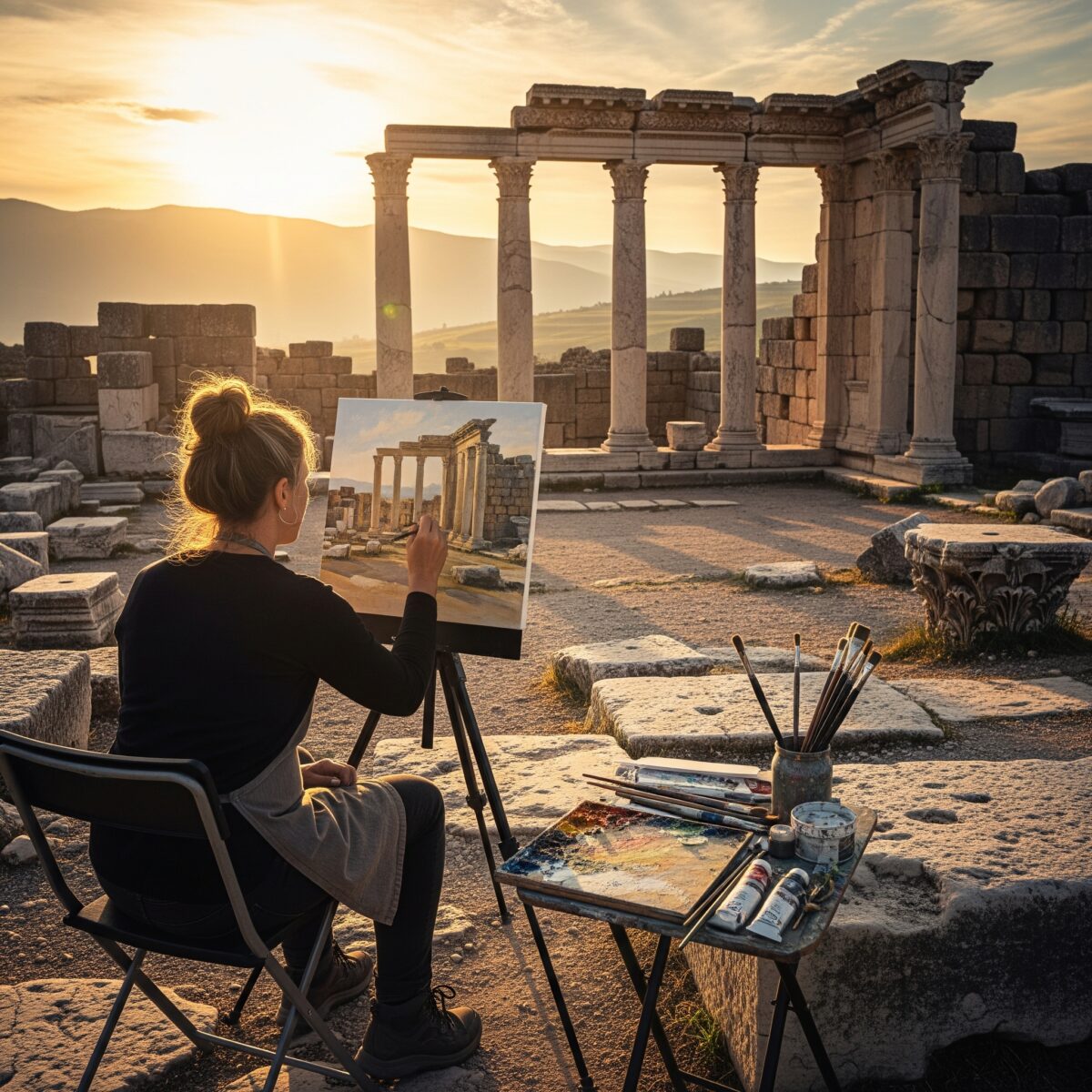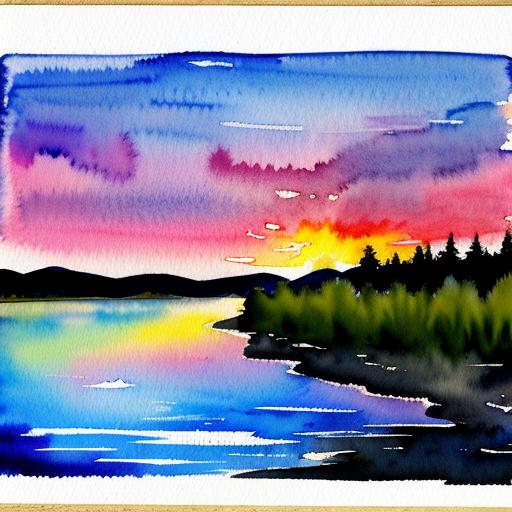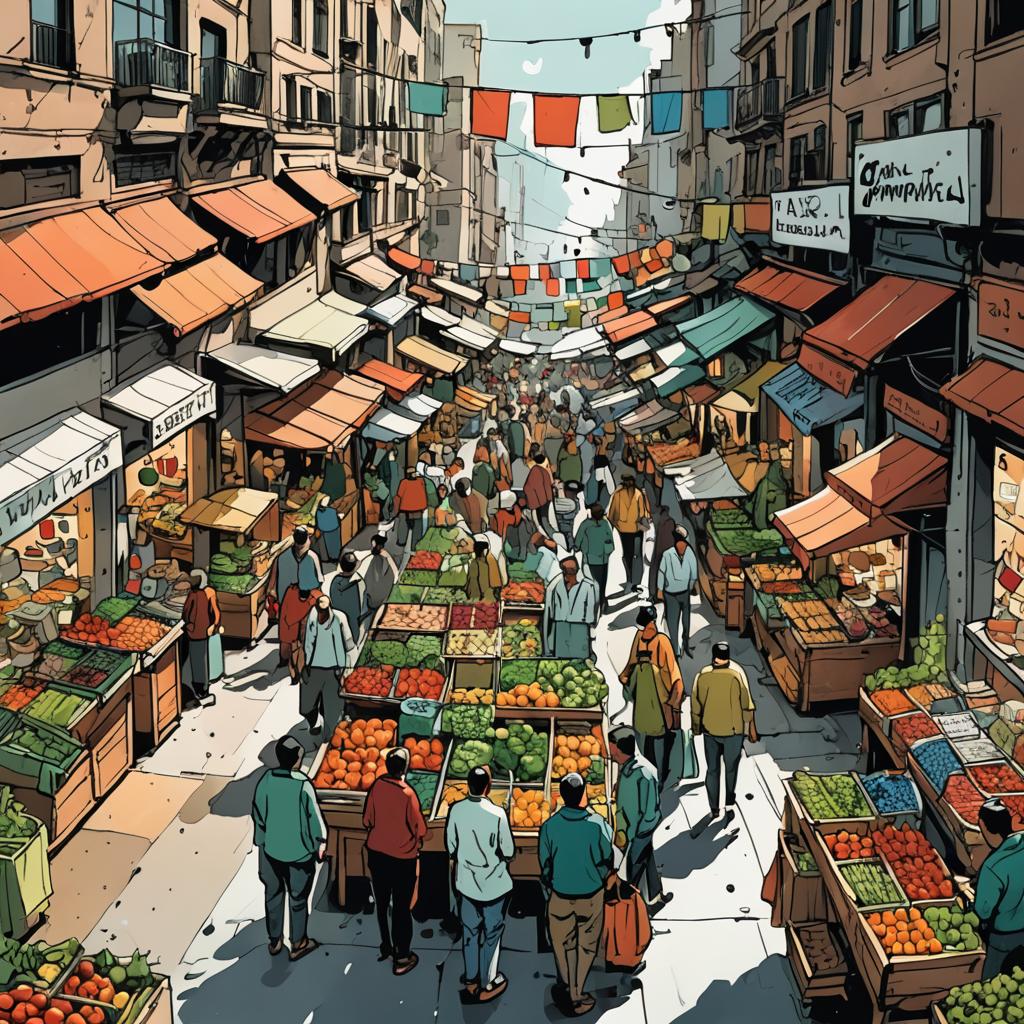When you’re searching for historical sites to visit that will inspire your next masterpiece, ancient ruins offer some of the most dramatic and captivating subjects for landscape painting. These weathered monuments tell stories of lost civilizations while providing artists with incredible textures, lighting opportunities, and compositional elements that simply can’t be found anywhere else. From the sun-drenched columns of Greek temples to the mysterious stone circles of ancient Britain, historical sites around the world offer endless inspiration for painters seeking to capture both natural beauty and human heritage in their work.
Key Points Summary
- Historical ruins provide unique artistic subjects with dramatic lighting and ancient textures
- Popular sites include Mediterranean coastal ruins, desert monuments, and mountain-top temples
- Essential planning involves researching photography restrictions, weather conditions, and best painting times
- Techniques for capturing stone textures, weathering effects, and atmospheric perspective are crucial
- Respectful practices and proper equipment ensure successful plein air painting sessions
Why Ancient Ruins Make Perfect Painting Subjects
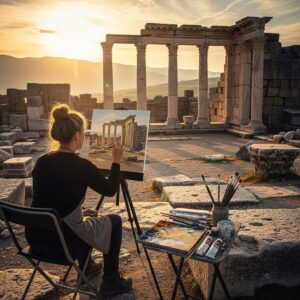
Ancient ruins possess a special magic that modern buildings simply can’t match. The weathered stone tells stories through every crack and shadow, while nature slowly reclaims these monuments, creating fascinating contrasts between human achievement and natural forces. When you set up your easel at these sites, you’re not just painting architecture – you’re capturing thousands of years of history.
The dramatic lighting conditions at historical sites change throughout the day, offering multiple painting opportunities from a single location. Early morning light creates long shadows that emphasize the three-dimensional quality of carved stone, while golden hour illumination transforms cold stone into warm, glowing surfaces that seem to radiate from within.
Top Historical Sites to Visit by Region
Mediterranean Ancient Sites
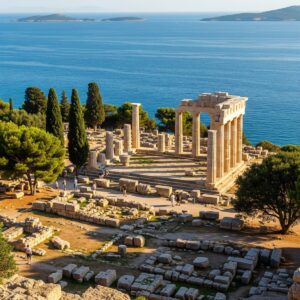
The Mediterranean region offers some of the world’s most accessible and paintable historical sites. Greece’s Acropolis provides stunning views over Athens, while the ancient theater at Epidaurus showcases perfect acoustics and dramatic hillside positioning. Italy’s Pompeii offers an entire frozen city to explore, with Mount Vesuvius providing a dramatic backdrop that reminds viewers of the site’s tragic history.
Coastal ruins present unique opportunities to combine seascapes with ancient architecture. Sites like the Temple of Poseidon at Cape Sounion offer breathtaking views where ancient columns frame endless ocean vistas, creating natural compositional elements that guide the viewer’s eye through your painting.
European Historical Monuments
Northern Europe’s historical sites offer different atmospheric qualities perfect for moody, atmospheric paintings. England’s Stonehenge creates mysterious silhouettes against dramatic skies, while Scotland’s ancient castles perch on clifftops overlooking misty landscapes. France’s medieval ruins dot the countryside, often surrounded by vineyards and rolling hills that provide context and scale.
Asian Temple Ruins
Asia’s ancient sites offer exotic architectural details and spiritual atmosphere. Cambodia’s Angkor Wat represents one of the world’s most impressive temple complexes, with intricate stone carvings emerging from jungle settings. Myanmar’s Bagan presents thousands of pagodas scattered across plains, creating endless compositional possibilities especially during sunrise and sunset.
Americas: Ancient Civilizations
The Americas offer unique pre-Columbian sites with distinctive architectural styles. Peru’s Machu Picchu combines Incan stonework with dramatic Andean mountain settings, while Mexico’s Chichen Itza and Palenque showcase Mayan achievements in tropical jungle environments. These sites often feature pyramid structures that create strong geometric elements in landscape compositions.
UNESCO World Heritage Sites for Artists
UNESCO World Heritage Sites receive protection that ensures their preservation while maintaining public access for artists and photographers. These designated sites offer several advantages for painters:
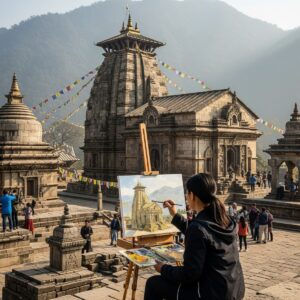
- Preserved authenticity means historical integrity remains intact
- Regulated tourism prevents overcrowding during certain hours
- Professional maintenance keeps sites accessible and safe
- Cultural significance adds depth and meaning to artistic interpretations
Popular UNESCO sites for painting include Jordan’s Petra, with its rose-colored facades carved into sandstone cliffs, and India’s Hampi, where boulder landscapes surround ancient temple complexes creating surreal, almost alien environments perfect for dramatic landscape paintings.
Planning Your Historical Painting Journey
Successful historical site painting requires careful preparation beyond just packing your essential painting supplies. Research each location’s specific restrictions, as many sites prohibit easels or have designated areas where artists can work.
Best Times for Painting
Early morning hours (6-9 AM) often provide the best conditions:
- Fewer tourists create cleaner compositions
- Soft, directional light enhances architectural details
- Cooler temperatures make outdoor painting more comfortable
- Security guards are typically more accommodating to artists
Late afternoon (4-7 PM) offers dramatic lighting but comes with challenges:
- Harsh shadows may obscure important details
- Tourist crowds peak during these hours
- Time pressure increases as closing times approach
Equipment Considerations
Pack lightweight, portable equipment since historical sites often require significant walking. A French easel or pochade box works better than heavy studio easels. Consider bringing:
| Essential Items | Optional Additions |
|---|---|
| Portable easel | Camping chair |
| Canvas panels | Umbrella/shade |
| Limited palette | Reference camera |
| Water containers | Sketching materials |
| Paper towels | Site guidebooks |
Artistic Techniques for Historical Architecture
Capturing Stone Textures
Ancient stone develops unique surface qualities through centuries of weathering. To paint these convincingly, observe how light reveals texture through subtle value changes rather than obvious brushstrokes. Use dry brush techniques to suggest rough surfaces, and remember that ancient stones often contain multiple colors within what appears to be uniform gray or beige surfaces.
Color mixing for ancient stone requires subtle combinations. Most ancient stones contain warm undertones even when they appear cool, so add tiny amounts of raw umber or burnt sienna to your base mixtures. Mediterranean stones often lean toward warm ochres, while northern European stones tend toward cooler grays with blue or purple undertones.
Composition Techniques for Ruins
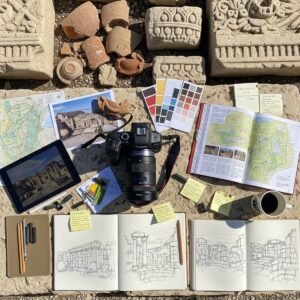
Historical sites present unique compositional challenges because they’re often partially destroyed or overgrown. Use these “imperfections” as creative opportunities:
- Leading lines created by fallen columns or ancient pathways
- Framing devices through archways or between standing columns
- Scale references by including small figures or vegetation
- Atmospheric perspective to show distance and depth
The golden ratio principles work exceptionally well with ancient architecture since many historical builders understood these mathematical relationships intuitively.
Weathering Effects and Atmosphere
Ancient ruins excel at creating atmospheric mood through their weathered surfaces and integration with natural environments. Paint the interaction between architecture and nature – vines growing through cracks, grass emerging between stones, or trees growing from within walls.
Atmospheric perspective becomes especially important when painting historical sites in landscape settings. Distant mountains or hills behind ruins should appear lighter and cooler than foreground architectural elements, helping establish the monumental scale of these ancient achievements.
Respecting Sacred and Cultural Sites
Many historical sites hold deep spiritual or cultural significance for local communities. Research the cultural context before painting, and always follow these guidelines:
“When painting at sacred sites, remember you’re a guest in a place that holds deep meaning for others. Your artistic practice should honor that significance.”
Archaeological Tourism Association
- Ask permission before setting up equipment
- Avoid blocking pathways or important viewing areas
- Dress appropriately for cultural expectations
- Research photography and sketching restrictions
- Consider hiring local guides to provide historical context
Advanced Reference Gathering Techniques
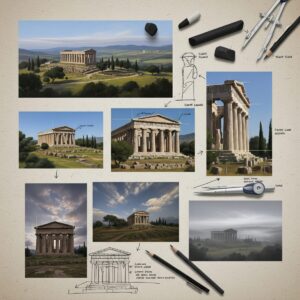
Professional results require comprehensive reference material. Combine multiple approaches for the most complete understanding of your subject:
Photography strategy: Take reference photos at different times of day to understand how light changes the site’s character. Include detail shots of stone textures, wide establishing shots for composition, and medium shots showing architectural relationships.
Sketching approach: Quick gesture sketches capture the essential character better than photographs. Focus on major shapes and value relationships rather than details. Creative sketchbook techniques help you develop personal shorthand for recording complex architectural information quickly.
Digital tools: Use smartphone apps to record GPS locations, compass directions for lighting studies, and voice notes about color observations that might be difficult to capture in sketches.
Popular Archaeological Sites by Accessibility
Not all historical sites require extensive hiking or travel to remote locations. Consider these factors when choosing destinations:
Highly Accessible Sites:
- Most European medieval ruins and Roman sites
- Greek and Italian archaeological parks
- Many UNESCO sites with visitor infrastructure
- Sites near major cities with public transportation
Moderate Access Required:
- Desert sites requiring guided tours or 4WD vehicles
- Mountain sites with established hiking trails
- Island sites accessible by ferry or boat
- Sites requiring permits or advance reservations
Adventure-Level Sites:
- Remote jungle temples requiring multi-day treks
- High-altitude sites requiring acclimatization
- Sites in politically unstable regions
- Newly discovered or restricted archaeological areas
Technical Painting Approaches for Different Site Types
Desert Historical Sites
Desert ruins like Petra or Egyptian monuments present unique painting challenges. The intense light creates extreme value contrasts, while dust and sand affect paint application. Use watercolor perspective techniques to capture the shimmering heat effects common in desert environments.
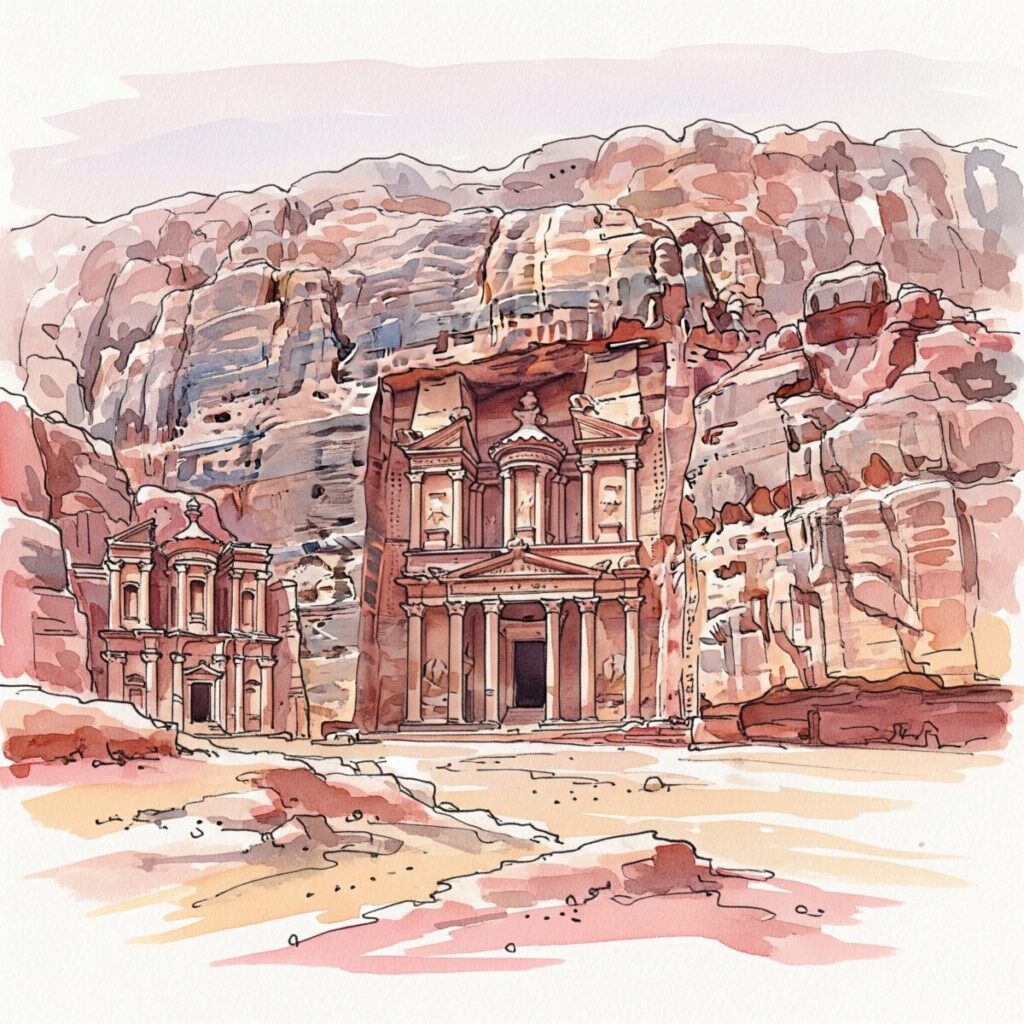
Color considerations: Desert light tends to be warm and intense, washing out subtle color variations. Emphasize warm shadows and use cooler colors sparingly for maximum impact.
Coastal Ancient Ruins
Seaside historical sites combine the challenges of seascape painting with architectural subjects. Salt air affects paint drying times, while reflected light from water illuminates stone surfaces in unique ways.
Atmospheric effects: Coastal sites often feature dramatic weather changes. Paint quickly to capture specific lighting conditions, or plan multiple sessions to document different atmospheric moods.
Forest and Jungle Sites
Overgrown ruins create fascinating interplays between architecture and vegetation. These sites require careful value control since heavy forest canopies create complex shadow patterns.
Vegetation integration: Don’t treat plants as separate from architecture – they’ve become part of the historical story. Show how nature reclaims human achievements while creating new forms of beauty.
Historical Sites to Visit: Planning Your Next Adventure
The world’s historical sites to visit offer unlimited inspiration for landscape painters willing to venture beyond traditional scenic locations. Whether you’re drawn to Mediterranean coastal ruins, mysterious desert monuments, or jungle-covered temples, each site provides unique opportunities to combine historical awareness with artistic expression.
Start planning your art weekend trip by researching sites that match your current skill level and travel preferences. Remember that the most important factor isn’t finding the most famous location – it’s choosing sites that inspire your personal artistic vision while respecting their cultural significance. These ancient places have witnessed countless sunrises and weathered thousands of storms, and now they’re waiting to become part of your artistic journey.
Top 10 Painters of Historical Sites & Ancient Ruins
| Painter | Notable Works/Style | Key Contribution/Era |
|---|---|---|
| Giovanni Paolo Panini (1691-1765) | Roman ruins, vedute (view paintings), capricci (architectural fantasies) | 18th Century; Master of architectural painting, documented Rome’s ancient and modern monuments. |
| Hubert Robert (1733-1808) | Romantic ruins, “Robert des Ruines”, landscapes with classical fragments | 18th Century; Known for his picturesque depictions of dilapidated ancient structures, often with figures. |
| J.M.W. Turner (1775-1851) | Romantic landscapes, Venice series, ancient Rome, dramatic light and atmosphere | 19th Century (Romanticism); Captured the sublime power of nature and the passage of time over man-made structures. |
| Thomas Cole (1801-1848) | Hudson River School, “The Course of Empire”, allegorical landscapes | 19th Century (American Romanticism); Explored themes of civilization’s rise and fall through ancient ruins in grand landscapes. |
| Caspar David Friedrich (1774-1840) | German Romanticism, contemplative landscapes with ruins, Gothic cathedrals | 19th Century (German Romanticism); Used ruins as symbols of decay, spirituality, and the ephemeral nature of human endeavor. |
| Louis Haghe (1806-1885) | Victorian architectural artist, lithographer, often depicted ruins with intricate detail | 19th Century; Renowned for his precise and detailed lithographs of historical and architectural subjects. |
| Sir Lawrence Alma-Tadema (1836-1912) | Neoclassical, highly detailed depictions of Roman and Egyptian daily life amidst ruins | 19th Century (Victorian); Known for bringing ancient history to life with meticulous archaeological accuracy and lush detail. |
| Canaletto (Giovanni Antonio Canal) (1697-1768) | Vedute of Venice, also created some ‘capricci’ featuring Roman ruins | 18th Century; While primarily known for Venice, his precision in architectural rendering influenced ruin painters. |
| David Roberts (1796-1864) | Orientalist painter, depicted ancient sites in Egypt, the Holy Land, and Syria | 19th Century; Documented exotic ancient ruins and landscapes, popularizing them for Western audiences. |
| Edward Lear (1812-1888) | Travel artist, landscapes of Greece, Italy, and the Middle East, often featuring ruins | 19th Century; Best known for his nonsense verse, but also a prolific and skilled landscape painter who captured many ancient sites. |
Frequently Asked Questions
What should I bring when visiting historical sites for painting? Pack lightweight, portable equipment including a pochade box or small easel, limited paint palette, water containers, canvas panels, and sun protection. Many sites restrict large equipment, so check regulations beforehand.
What’s the best time to visit ancient ruins for painting? Early morning (6-9 AM) typically offers the best conditions with fewer crowds, dramatic lighting, and cooler temperatures. Late afternoon provides golden hour lighting but comes with larger tourist crowds.
How do I prepare for historical site painting visits? Research site-specific restrictions, photography rules, and cultural sensitivities. Check weather conditions, pack appropriate clothing, and consider hiring local guides for historical context and location insights.
What photography equipment works best for historical sites? A DSLR or mirrorless camera with telephoto lens captures architectural details, while wide-angle lenses work for establishing shots. Bring extra batteries and memory cards, plus a tripod for low-light conditions.
What painting supplies work best for outdoor historical painting? Choose a limited palette of essential colors, bring plenty of paper towels, use canvas panels instead of stretched canvases, and pack everything in a sturdy, organized carrying case designed for plein air painting.
How do I paint realistic stone textures found in ruins? Observe how light reveals texture through value changes rather than obvious brushwork. Use dry brush techniques, mix subtle color variations within apparent grays, and remember that ancient stones contain multiple hues.
Important Resources
Planning and Research:
- UNESCO World Heritage List – Official database of protected historical sites
- Archaeological Institute of America – Professional archaeological information and site guidelines
Artistic Development:
- How to Create a Realistic Landscape Painting: A Comprehensive Guide
- The Complete Guide to Light and Shadow: Master Visual Depth in Your Art
- Essential Guide to Painting Supplies for Artists
Cultural Awareness:
- International Council on Monuments and Sites – Heritage conservation and cultural site guidelines
- Local tourism boards and archaeological site official websites for specific regulations and cultural protocols

